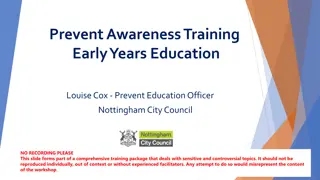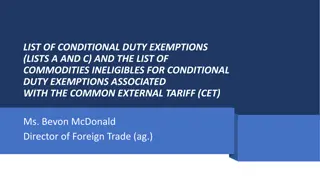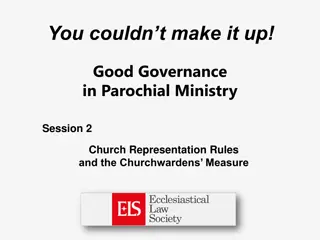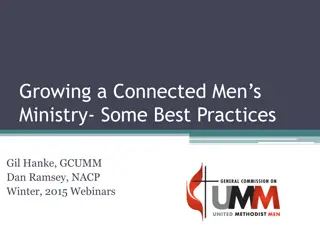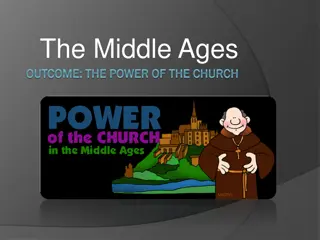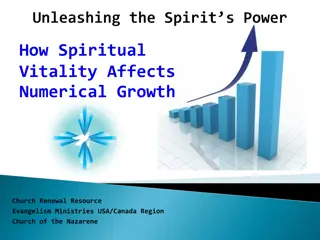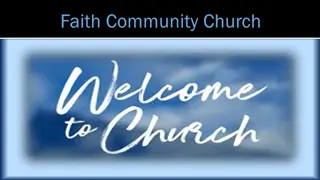The Church's Duty in Ministering to People's Needs
The duty of the church in ministering to people's needs is essential for credibility and effective communication of the gospel message. Wesley's model of holistic care, combining evangelism and compassionate ministries, highlights the importance of serving others in a practical and tangible way. By engaging in caring ministries, new disciples can embody the gospel in their lives, moving beyond mere proclamation to behavioral discipleship. Additionally, the church faces challenges in cross-cultural service, with the need to empower indigenous converts for sustainable ministry.
Download Presentation

Please find below an Image/Link to download the presentation.
The content on the website is provided AS IS for your information and personal use only. It may not be sold, licensed, or shared on other websites without obtaining consent from the author.If you encounter any issues during the download, it is possible that the publisher has removed the file from their server.
You are allowed to download the files provided on this website for personal or commercial use, subject to the condition that they are used lawfully. All files are the property of their respective owners.
The content on the website is provided AS IS for your information and personal use only. It may not be sold, licensed, or shared on other websites without obtaining consent from the author.
E N D
Presentation Transcript
To Spread the Power by George G. Hunter III Chapter Six: Ministering to People s Needs
Ministering to People's Needs The secular world knows or expects, that whatever else churches do, they minister, especially to people with needs. If no other part of Christianity s image is clear, that part is clear, and valid. Our Lord said that He came not to be served, but to serve, and He calls His church to this ministry.
Wesleys Views For Wesley, pastoral care was the responsibility of the whole fellowship. Wesley devised some institutionalized approaches to assist poor people: Established a fund so poor people could get emergency interest-free loans. Opened a dispensary for the poor and a home for aged persons and infirm widows. Established a school for poor children.
A Skewed Image Most Christians have (mis)perceived evangelism and care giving as two stand alone ministries. To introduce people to Christ and invite them to respond and become disciples is a serving ministry.
The Churchs Duty 1. The Church s service and compassionate ministries provide the credibility for its message. Most people do not find believable, or worth considering, the message of a church that just preaches .
The Churchs Duty 2. Some facets of the Church s gospel are better communicated through the Church s service (diakonia) or fellowship (koinonia) than merely through proclamation (kerygma).
The Churchs Duty 3. Involving new disciples in caring ministries is a necessary phase of their conversion, enabling the gospel to be incarnated in their personalities and life-styles, and not confined to the cognitive and affective parts of their personalities. True discipleship is behavioral.
The Churchs Duty 4. In cross-cultural service, the church has two options: (a) Raise up enough indigenous converts for them to (more effectively) minister to their people (b) keep sending (less effective) cross-cultural servants, thereby keeping the recipient population dependent on the sending population. The critics of missions complain in either case: If missionaries convert people, it is labeled imperialism ; if they do not raise up a strong indigenous church but continue serving, it is labeled paternalism .
The Churchs Duty 5. The legitimate social reform objectives of the church in any society are only achieved when the movement recruits and develops a sufficiently large number of disciples to pursue social objectives effectively. Evangelism provides the personnel for Christ s whole mission in the world. People only become involved in ministry, social reform, and witness as they experience grace, join the messianic community, and come to share God s own dream of the Kingdom that is to be.
The Churchs Duty 6. Because of redemption and lift, that is, the rise in dignity, self-esteem, education, and hope that accompanies most any people s experience of being evangelized and discipled, faithful evangelism may be the most effective method of liberating people from disadvantage and oppression and for reforming a society.
The Churchs Duty 7. There is an inevitable relationship between attaining a just society and fashioning some just people within that society. Without doubt the relationship is reciprocal: A just society provides a climate that makes Christianity s message believable, that is, congruent with some of the people s experiences in that just society; and a society is more likely to approximate justice when some community is modeling justice and producing altruistic people who work for justice. Logically, an effective movement for justice in any society has to begin with enough justice-seeking persons.
A lesson from Luke 5:12-14 Social Leprosy Leprosy In today s society AIDS Drunkeness Homelessness Gays
Care for Gods people takes: Kerygma proclaiming; preaching/teaching Koinonia fellowship; building relationships Diakonia: service; builds credibility
Churchs response To be a prophetic church working in season and out toward reform of those institutions, laws, customs, and habits that afflict people with closed doors, powerlessness and low self-esteem. To be a serving church finding colonies of lonely, dispossessed, lost, powerless losers who are often afflicted with low self-esteem To be a communicating church sharing the message and possibility of grace, reconciliation, and new life.
People become Christians when they turn toward, and become faithfully involved with: Christ the gospel the church the world These four turnings generally take place one at a time in a person s life, but in any conceivable order.
Steps to a Marketing Strategy Gather the needs andwants of the targeted population by: Interviewing including those within the targeted population and experts that work with them or posses information. Observing in unobtrusive ways. Reading relevant literature.
Steps to a Marketing Strategy Design ministries that may help that target population. Include as many members of the target population in the planning. They will provide insight as to what data is needed and what problems may occur.
Steps to a Marketing Strategy Communicate the offer of ministry to the targeted groups. Be redundant, using personal invitations and appropriate community media. Present the program, ministry, or service with the best management, execution, and human relations possible, and with evangelical follow-through.
What might a Churchs Marketing Strategy/Approach look like? pg.141-142 Start with teens Central United Protestant Church Start with community needs Sunrise United Methodist Church Start with a specific group/ move to other groups Aldersgate United Methodist Church.
What might a Churchs Marketing Strategy/Approach look like? Kingsway Cr che-for children St. Luke s House-for alcoholic men Stirling Court and Argyll House- second stage houses for alcoholic men St. Mary s House-for alcoholic women Grove House-for unmarried expectant mothers Alfred Hartley House-for elderly women Emerson Bainbridge House-residence for young people Fellowship House-Residence for young people Hopedine-for unmarried mothers and their babies Katherine Price Hughes Hostel-for girls in need of care and supervision WLM Clothing Store-for those with little money
What can we learn from chapter 7? We can catch more flies with honey than we can with vinegar. LOVE PEOPLE TO THE LORD IN REACHING OUT AND BEING THE CHURCH CHRIST HAS CALLED US TO BE!
This PowerPoint presentation is available along with related materials and other PowerPoint presentations at http://home.snu.edu/~hculbert/ppt.htm




